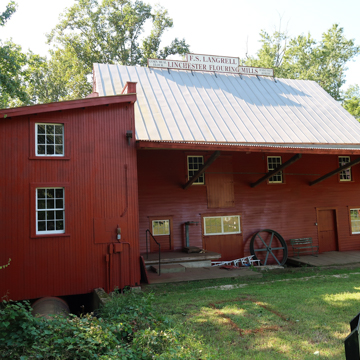This is one of two surviving mills of the approximately twenty-five that once formed Caroline County’s chief industry. It is also its most intact and was the last to operate, prior to its closure in 1979. The interior encompasses milling equipment spanning the course of two centuries, retaining elements of the labor-saving, grain elevator technology developed by Oliver Evans in the eighteenth century while introducing the roller mill system developed c. 1890. Although this mill was not erected until about 1840, there has been a mill here at the head of Upper Hunting Creek since the 1680s. The three-bay frame building was erected by Jacob C. Willson, with a fourth bay added by then-owner John Nichols. Lean-to sections were added as improvements in milling equipment were made; c. 1897, S. L. Webster installed the Wolf Roller machinery, and after his purchase in 1918 Frank Langrell replaced the turbines with a Fitz overshot water wheel.
The site includes the c. 1840 miller’s house, a two-story, five-bay, frame I-house featuring Greek Revival corner pilasters and a small frame house for the miller’s assistant. The 1879 Hog Island School, a traditional one-room, gable-front schoolhouse with bell cote, was moved to the site.
As a rare surviving mill, the building was purchased by Caroline County Historical Society in 2003 and is now a museum. Also extant is the Williston Mill and Miller’s House (c. 1830; 25729 Williston Road); although the mill suffered a fire, it was restored and is also open to the public.









